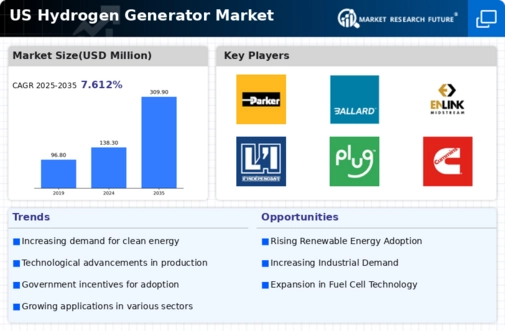The US Hydrogen Generator Market is rapidly evolving, driven by the increasing demand for clean energy solutions and the push for sustainable technologies. As organizations and governments look to reduce their carbon footprints, hydrogen generators serve as a key component in the transition towards greener energy. Various technologies such as electrolysis and steam methane reforming are being employed, contributing to a competitive landscape populated by numerous players. In this context, companies are not only focusing on technological advancements but also on enhancing operational efficiencies and expanding their market presence.
Thus, the competitive insights gathered from this market reflect the innovative strategies and diverse offerings that cater to both industrial and commercial needs. Parker Hannifin has established a noteworthy presence in the US Hydrogen Generator Market by leveraging its extensive technological expertise and robust manufacturing capabilities. The company’s strengths lie in its advanced engineering solutions that enable the efficient production of hydrogen. With a significant emphasis on research and development, Parker Hannifin continuously enhances its product offerings, allowing it to meet the diverse requirements of clients across various sectors, including energy and transportation.
The company's commitment to sustainability further strengthens its market position, as it aligns with the growing trend toward renewable energy. Moreover, Parker Hannifin's extensive distribution network ensures a reliable supply chain, facilitating prompt service delivery and customer support throughout the United States.Ballard Power Systems is another prominent player in the US Hydrogen Generator Market, known for its innovation in fuel cell technology. The company focuses on providing high-performance fuel cell systems that convert hydrogen into clean electricity, catering primarily to the transportation and stationary power sectors.
Ballard Power Systems distinguishes itself through its comprehensive solutions that include the design, development, and manufacturing of hydrogen fuel cells, enabling its customers to transition to zero-emission technologies. The company has strategically entered into partnerships and collaborative ventures, enhancing its market position while fostering integration with other energy technologies. Additionally, Ballard Power Systems is involved in various strategic mergers and acquisitions aimed at expanding its capabilities and product offerings, allowing it to strengthen its foothold in the US hydrogen landscape.
Their ongoing innovations and alignment with market demands bolster their competitive edge, making them a significant force in the hydrogen generator market.





















